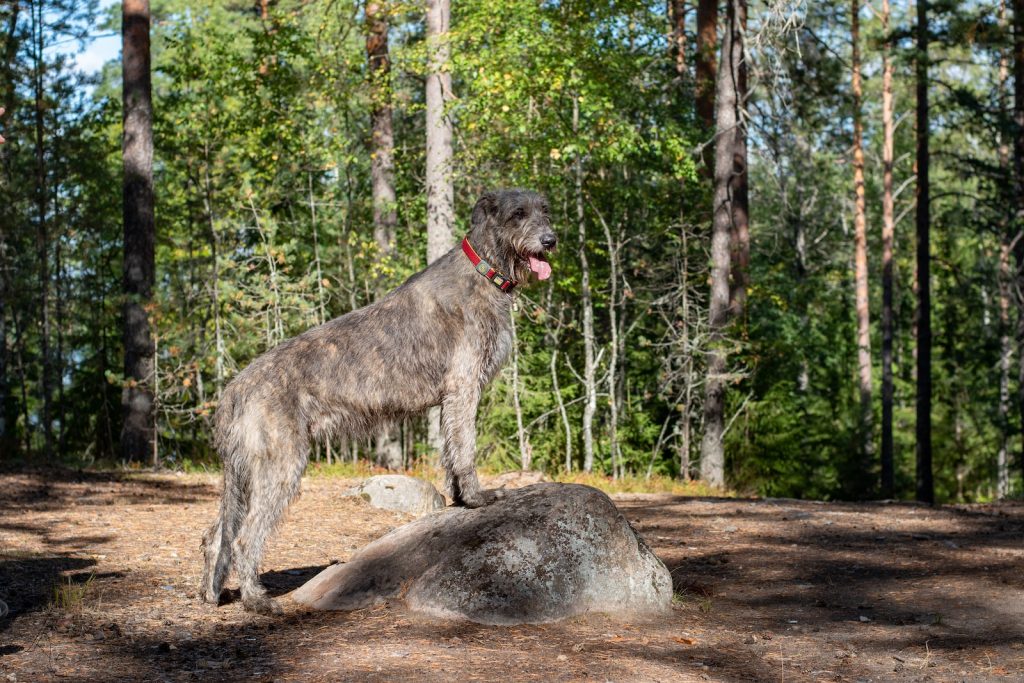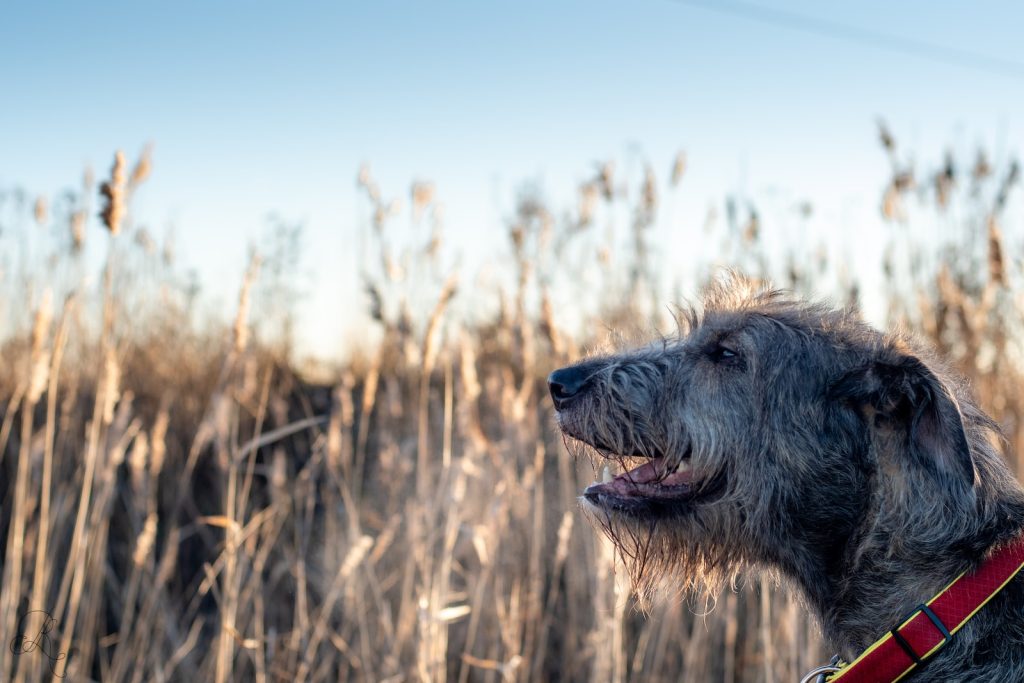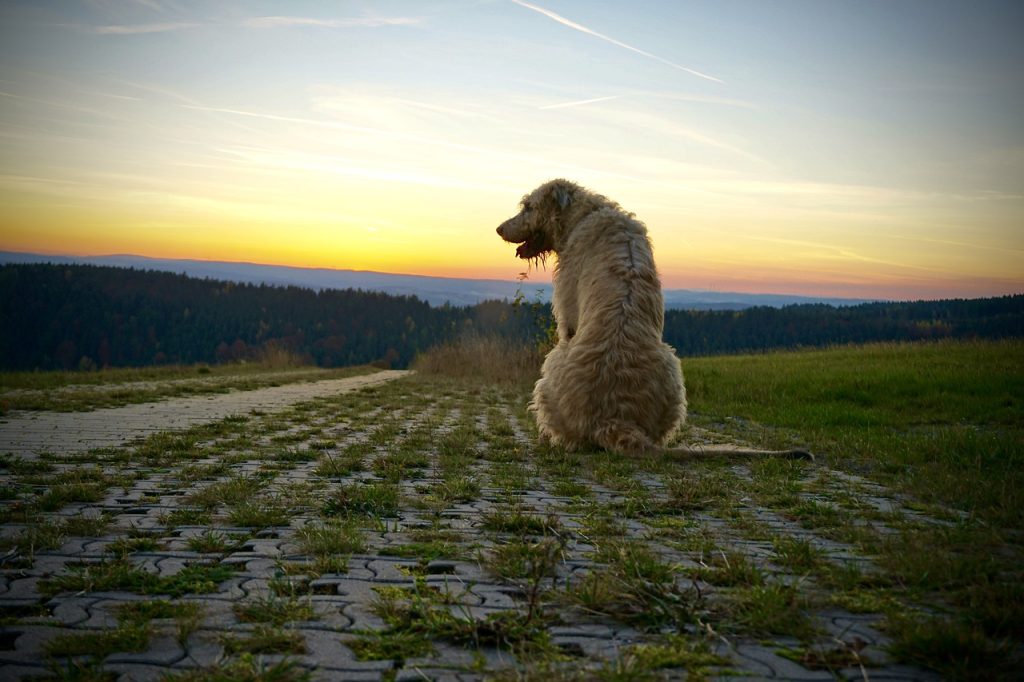The Irish Wolfhound is an awe-inspiring breed that embodies both elegance and strength. Renowned for its towering height and noble appearance, this gentle giant holds a special place in the hearts of dog lovers worldwide. This comprehensive guide delves into the captivating history, distinctive characteristics, temperament, grooming needs, training requirements, health considerations, and more about the magnificent Irish Wolfhound.
Key Takeaways:
- Explore the fascinating history and origin of the Irish Wolfhound.
- Discover the distinctive characteristics and temperament of this majestic breed.
- Learn about the grooming needs, training requirements, and health considerations for Irish Wolfhounds.
- Find out if the Irish Wolfhound is the right breed for you and your family.

History and Origin of the Irish Wolfhound
The Irish Wolfhound’s history traces back to ancient times, where its origins intertwine with legends and folklore. Let’s journey through time to explore the captivating story behind this majestic breed.
Origins in Ancient Ireland
The roots of the Irish Wolfhound can be found in ancient Ireland, where they were revered for their exceptional hunting prowess and loyal companionship. Bred by the Celts, these dogs were esteemed for their ability to hunt wolves, deer, and even Irish elk. Their immense size and strength made them invaluable assets to the Celts in their pursuit of game.
Influence of the Greyhound and Deerhound
During the 16th century, the Irish Wolfhound faced a decline in numbers due to several factors, including the scarcity of game and political unrest. However, efforts to revive the breed were undertaken by dedicated enthusiasts. The Irish Wolfhound was crossbred with the Greyhound and Scottish Deerhound to revitalize the breed, resulting in a refined and more versatile dog.
Recognition and Preservation
In 1885, the Irish Wolfhound was recognized by the American Kennel Club (AKC), and the breed gained worldwide recognition. Thanks to the tireless efforts of breed enthusiasts and responsible breeders, the Irish Wolfhound was saved from the brink of extinction. These majestic dogs continue to captivate hearts with grace, charm, and gentle nature.
Distinctive Characteristics and Temperament
Majestic Stature and Physical Appearance
The Irish Wolfhound is undeniably one of the largest dog breeds in the world. Males are typically 32 inches (81 cm) tall at the shoulder, with ladies slightly shorter but no less magnificent. Their massive size and long, lean bodies give them a commanding presence demanding attention and respect.
Noble and Gentle Demeanor
Irish Wolfhounds are known for their gentle and friendly temperament, unlike their imposing size. Often described as the “gentle giants” of the dog world, they are known to be highly affectionate and bond closely with their families. Their calm and patient nature makes them excellent companions for people of all ages, including children.
Sociable and Welcoming
Irish Wolfhounds are generally friendly and welcoming to both humans and other animals. Their friendly disposition and lack of aggression make them popular for families seeking a gentle and reliable companion. However, early socialization and proper training are crucial to ensure they grow into well-rounded and confident dogs.
Strength and Agility
Despite their gentle nature, this breed possesses remarkable strength and agility. Their athletic build and powerful physique allow them to excel in various activities, including lure coursing, obedience trials, and even agility competitions. Regular exercise and mental stimulation are essential to keep these magnificent dogs happy and healthy.
Grooming Needs of the Irish Wolfhound
While the this breed’s size may seem daunting, their grooming needs are surprisingly manageable. Let’s delve into the critical aspects of grooming this majestic breed.
Coat Type and Care
This breed boasts a double coat consisting of a coarse and wiry outer coat and a soft undercoat. This combination provides them with protection against harsh weather conditions. Regular brushing, at least once or twice a week, helps remove loose hair and prevents matting. Additionally, occasional hand-stripping may be necessary to maintain the coat’s texture and appearance.
Bathing and Hygiene
Due to their large size, bathing an Irish Wolfhound can be challenging. However, washing them every two to three months or as needed is recommended. A gentle, high-quality dog shampoo on their skin and coat is essential to prevent dryness and irritation. Regularly cleaning their ears, trimming their nails, and brushing their teeth is crucial to maintaining their overall hygiene.
Seasonal Shedding
Like most double-coated breeds, this breed experience seasonal shedding. During shedding seasons, typically in spring and fall, they may require more frequent brushing to remove dead hair and prevent excessive shedding throughout the home. Providing a healthy and balanced diet, along with regular grooming, can help minimize shedding.
Training and Exercise Requirements
Training an Irish Wolfhound requires patience, consistency, and positive reinforcement. As intelligent dogs, they respond well to reward-based training methods. Here’s what you need to know about training and exercising this majestic breed.
Early Socialization
Early socialization is vital for Irish Wolfhound puppies to develop into well-mannered adults. During critical socialization, introducing them to various people, animals, sounds, and environments helps them become confident and adaptable dogs. Enrolling them in puppy socialization classes and exposing them to different experiences in a positive and controlled manner is highly recommended.
Obedience Training
They are generally eager to please and respond well to positive reinforcement training methods. Consistency, patience, and using rewards such as treats and praise are essential to motivate them during training sessions. Focusing on basic commands such as sit, stay, come, and loose leash walking helps establish a strong foundation for their obedience training.
Exercise Needs
They are relatively moderate in their exercise requirements despite their imposing size. Daily walks and opportunities for off-leash running in a securely fenced area are essential for their physical and mental well-being. Engaging in activities that allow them to utilize their instincts, such as lure coursing or scent work, can provide them with additional mental stimulation and enrichment.
Health Considerations for Irish Wolfhounds
Like all dog breeds, they are prone to various health issues that prospective owners should be aware of. Regular veterinary check-ups and a proactive approach to their healthcare are crucial for ensuring their well-being.
Common Health Issues
They are generally healthy but predisposed to certain genetic health conditions. These can include heart disease, bloat (gastric dilation volvulus), hip and elbow dysplasia, and certain types of cancer. Responsible breeders perform health screenings on their breeding dogs to minimize the risk of passing on these conditions to offspring. Regular veterinary care, a balanced diet, and appropriate exercise can help prevent or manage these conditions.
Lifespan and Size Considerations
They have a relatively short lifespan compared to smaller dog breeds, typically ranging from 6 to 8 years. Their rapid growth during puppyhood should be closely monitored to prevent developmental issues. Providing a nutritionally balanced diet appropriate for large breeds and avoiding excessive exercise during their growth stages can help ensure they develop strong bones and joints.
Living Space Considerations
Due to their large size, this breed often needs vast living spaces such as rural properties or large yards. However, they can adapt well to various living arrangements, including apartments, if their exercise and mental stimulation needs are met.
Indoor Living
While Irish Wolfhounds enjoy spending time outdoors, they are primarily indoor companions. Their calm and gentle nature makes them well-suited for apartment living, provided they receive regular exercise and mental enrichment. However, ensuring they have enough space to stretch out comfortably and have regular opportunities for outdoor activities is essential for their well-being.
Fenced Yard
A fenced yard can provide this breed with a safe space to exercise, explore, and play. The fence should be sturdy and tall enough to prevent them from jumping over or digging under it. It’s important to note that Irish Wolfhounds should always be supervised for extended periods, as they thrive on human companionship.
Socialization and Interaction
They are social dogs that thrive on companionship and interaction with their human family members. They are known to be gentle and patient with children, making them an excellent choice for families. However, their large size makes supervision crucial to ensure safe and positive interactions between dogs and children.
Interaction with Other Pets
Irish Wolfhounds generally get along well with other pets, including dogs and cats, when properly introduced and socialized from an early age. Supervision is necessary during initial interactions to ensure everyone gets along harmoniously. Proper introductions, positive reinforcement, and gradual exposure are critical to successful integration into a multi-pet household.
Caring for an Irish Wolfhound
Caring for an Irish Wolfhound goes beyond meeting its basic needs. This breed requires a loving and dedicated owner who can provide the care and attention they deserve.
Nutritional Needs
This breed has specific dietary requirements due to its large size and potential health concerns. It is critical to provide them with a high-quality, nutritionally balanced meal appropriate for their age, size, and activity level. Consultation with a veterinarian or a canine nutritionist can help determine the best diet plan for your Irish Wolfhound.
Regular Veterinary Care
Regular veterinary check-ups are essential for maintaining your Irish Wolfhound’s health and well-being. Vaccinations, parasite prevention, dental care, and routine blood tests are all part of their preventive healthcare routine. Your veterinarian can guide when to schedule these visits and what additional screenings may be necessary based on your dog’s specific needs.
Mental Stimulation and Enrichment
They are intelligent dogs that benefit from mental stimulation and enrichment activities. Providing interactive toys, puzzle feeders, and training sessions keeps them mentally engaged and strengthens the bond between you and your dog. Regular exercise, exploration of new environments, and positive social interactions are all vital components of their mental well-being.
Adopting an Irish Wolfhound
Adopting an Irish Wolfhound can be a rewarding experience. It allows you to provide a loving home to a dog in need while experiencing the unique joys and challenges that come with this majestic breed.
Rescue Organizations and Shelters
Some reputable rescue organizations and shelters specialize in Irish Wolfhounds or large breeds. These organizations work tirelessly to rescue, rehabilitate, and rehome Irish Wolfhounds needing forever homes. Adopting such organizations gives a deserving dog a second chance at a happy life and allows you to experience the unique bond shared with a rescue dog.
Responsible Breeders
If you purchase an Irish Wolfhound from a breeder, it is crucial to ensure they are responsible and ethical. Responsible breeders prioritize the health, temperament, and well-being of their dogs. They perform health screenings on their breeding dogs, provide a clean and stimulating environment, and offer ongoing support and guidance to puppy buyers.

Frequently Asked Questions
Is an Irish Wolfhound bigger than a Great Dane?
Yes, Irish Wolfhounds are generally taller than Great Danes, making them one of the tallest dog breeds in the world.
Is an Irish Wolfhound bigger than a wolf?
While Irish Wolfhounds are large dogs, they are generally not bigger than wolves in terms of size. However, their gentle temperament differs significantly from that of a wild wolf.
Is an Irish Wolfhound a good pet?
Irish Wolfhounds can make excellent pets for the right owner. Their gentle nature, loyalty, and affectionate disposition make them perfect companions. However, their large size and specific needs should be carefully considered before bringing one into your home.
Is the Irish Wolfhound the largest dog in the world? How rare are Irish Wolfhounds?
While the Irish Wolfhound is one of the tallest dog breeds, it is not considered the largest in weight. The breed is relatively rare but not exceptionally so. Responsible breeders and breed-specific rescue organizations can help connect potential owners with Irish Wolfhounds.
Are Irish Wolfhounds good with children?
Irish Wolfhounds are generally good with children and often exhibit patience and gentleness. However, supervision is necessary to ensure safe interactions between dogs and children, primarily due to the large Irish Wolfhound.
How much exercise do Irish Wolfhounds need?
Despite their large size, Irish Wolfhounds have moderate exercise needs. Daily walks and opportunities for off-leash running in a securely fenced area are essential. Cognitive stimulation, such as puzzle toys and training programs, also benefits their health.
Conclusion
The Irish Wolfhound’s majestic stature and gentle nature have captivated dog lovers throughout history. Understanding the breed’s history, distinctive characteristics, temperament, grooming needs, training requirements, health considerations, and living space requirements is essential for potential owners. Whether you adopt or purchase an Irish Wolfhound, providing a loving and dedicated home is vital to ensuring a fulfilling and harmonious life with this magnificent breed. The Irish Wolfhound’s loyalty, affection, and regal presence will undoubtedly make it a cherished companion for those who can share their lives with this remarkable dog.
Give Strays and Unwanted Dogs a Second Chance at Life
At Bone Voyage Dog Rescue, we are committed to making a difference by finding loving homes for abandoned and abused dogs. Our adoption program is designed to match each dog with the most suited home based on its individual characteristics. Adopting a dog from us provides them with a new home and an opportunity to live a happy life.
Discover the thrill of adoption and forever alter a dog’s life. To begin the adoption process, please get in touch with us at [email protected].
Make a Difference with a Transitional Home!
Another method to make a huge difference is to foster a dog. While waiting for their forever family, provide a safe and loving environment for a dog. It’s a fantastic opportunity to make a difference without committing to anything long-term. Contact us at [email protected] if you are interested in fostering.
Participate in Something Special!
Volunteers play an important role in our team, from walking dogs to organizing events. You may make a significant difference in the lives of our furry friends by joining our committed group of volunteers. If you’d like to help and be a part of our team, please email us at [email protected].
Take the First Step Right Now!
Call us at +52 3329718011 to learn more about our adoption program or to bring home a new companion. We can give these canines a second opportunity at a happy life together.
Keep in mind that every action counts! Adopt, foster, or volunteer today to make a difference in the lives of these worthy dogs.

